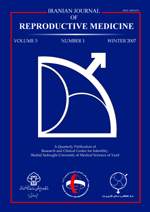
|
International Journal of Reproductive BioMedicine
Research and Clinical Center for Infertility, Shahid Sadoughi University of Medical Sciences of Yazd
ISSN: 1680-6433
EISSN: 1680-6433
Vol. 10, No. 3, 2012, pp. 193-200
|
 Bioline Code: rm12028
Bioline Code: rm12028
Full paper language: English
Document type: Research Article
Document available free of charge
|
|
|
International Journal of Reproductive BioMedicine, Vol. 10, No. 3, 2012, pp. 193-200
| en |
Expression of pluripotency markers in human granulosa cells after embryonic stem cell extract exposure and epigenetic modification
Talaei-Khozani, Tahereh; Kharazinejad, Ebrahim; Rohani, Laili; Vojdani, Zahra; Pour, Zohreh Mostafavi & Tabei, Seyed Ziaadin
Abstract
Background: Epigenetic reprogramming of differentiated cells can modify somatic cells into pluripotential state. Pluripotency can be induced in somatic cells by several approches. One of the easy ways to induce pluripotency is the exposure of the somatic cells to the embryonic stem cell (ESC) extract.
Objective: The objective of this study was to increase the efficiency of reprogramming of granulosa cell as a differentiated cell into pluripotential state by using epigenetic modifier agents and extract.
Materials and Methods: The human granulosa cells were cultured in the medium containing 5-Aza-Deoxycytidine and trichostatin A. Then, the cells were exposed to mouse ESCs extract and co-cultured with mouse embryonic fibroblast in the presence of leukemia inhibitory factor (LIF). Alkaline phosphatase test and also immonohistochemistery staining for Oct4, Sox2 and Nanog were performed after 24 and 72 hours and 1 week.
Results: The granulosa cells showed the alkaline phosphatase activity after 24 hours and the enzyme activity maintained for 72 hours. They also expressed Oct4 after 24 hours. The cells also expressed Sox2 and Nanog, 72 hours after exposure to the ESCs extract. The expression of the pluripotency markers decreased after 1 week. It seems that the extract can induce dedifferentiation in granulosa cells and they can express the stem cell markers.
Conclusion: It seems that the inhibitors of the methyl transferase (5-Aza-Deoxycytidine) and histone deacetylase (trichostatin A) could delete the epigenetic markers and prepare the cells for reprogramming by administration of the extract.
Keywords
Cell free extract, Embryonic stem cell, 5-Aza-Deoxycytidine, Reprogramming, Trichostatin A
|
| |
© Copyright 2012 - Iranian Journal of Reproductive Medicine
Alternative site location: http://www.ijrm.ir
|
|
